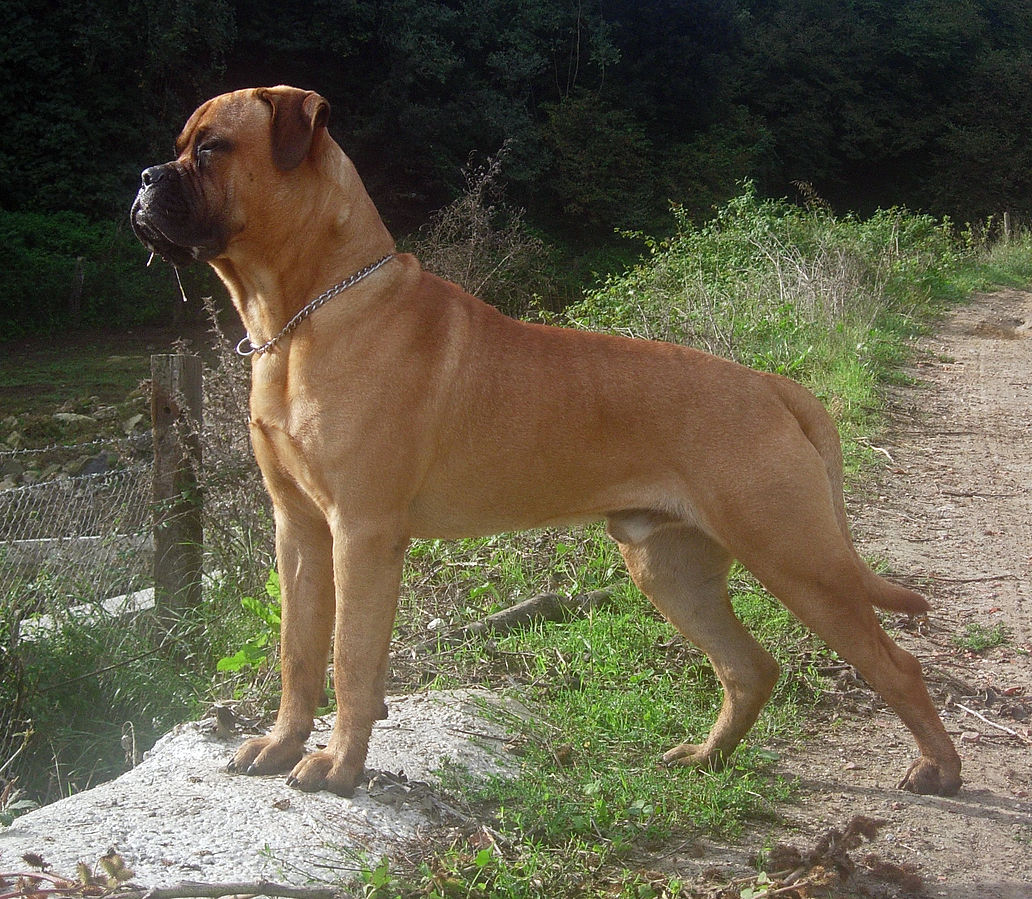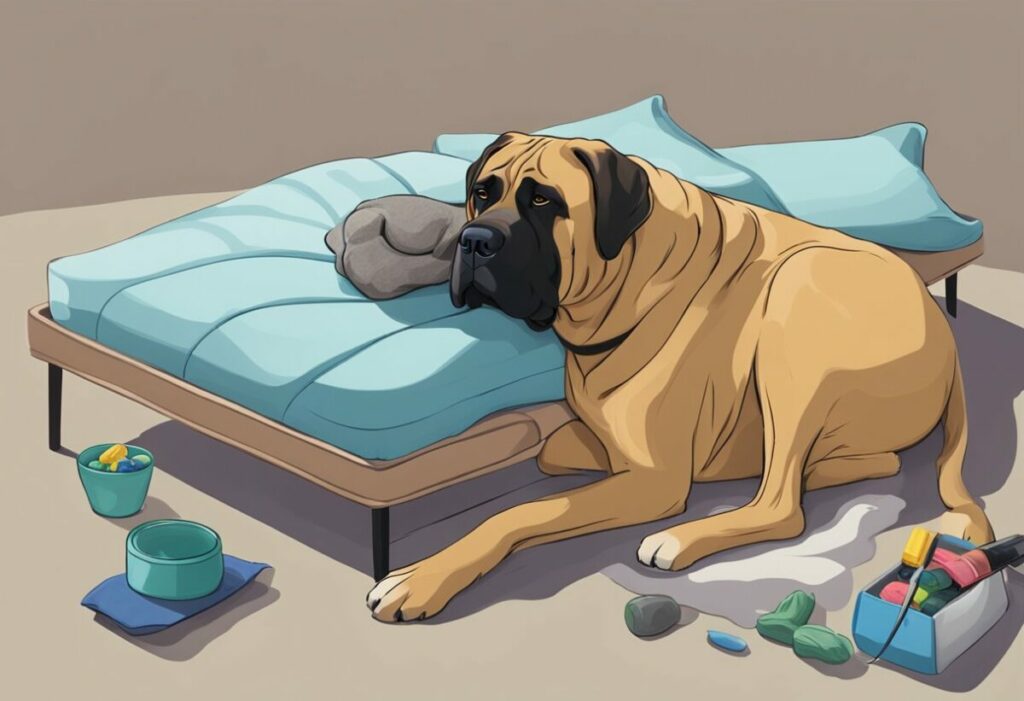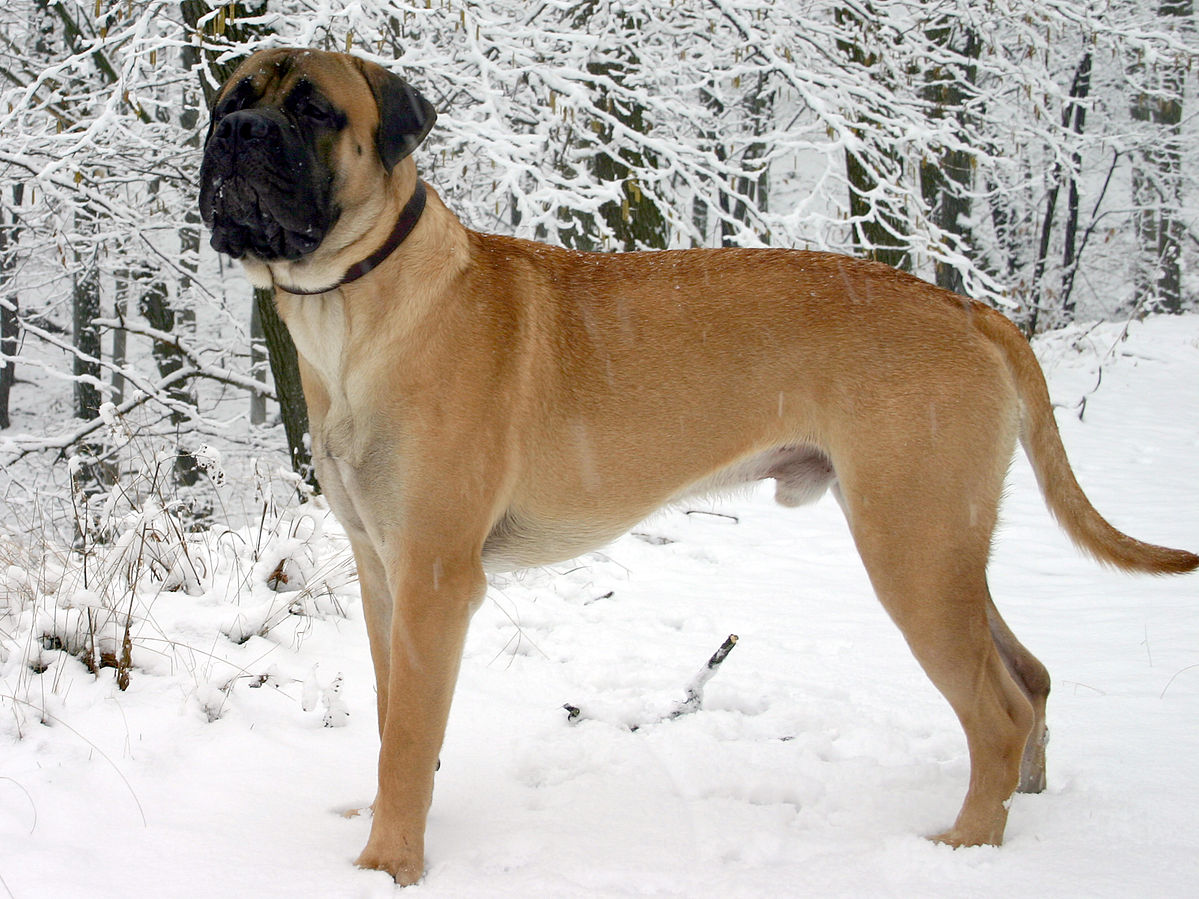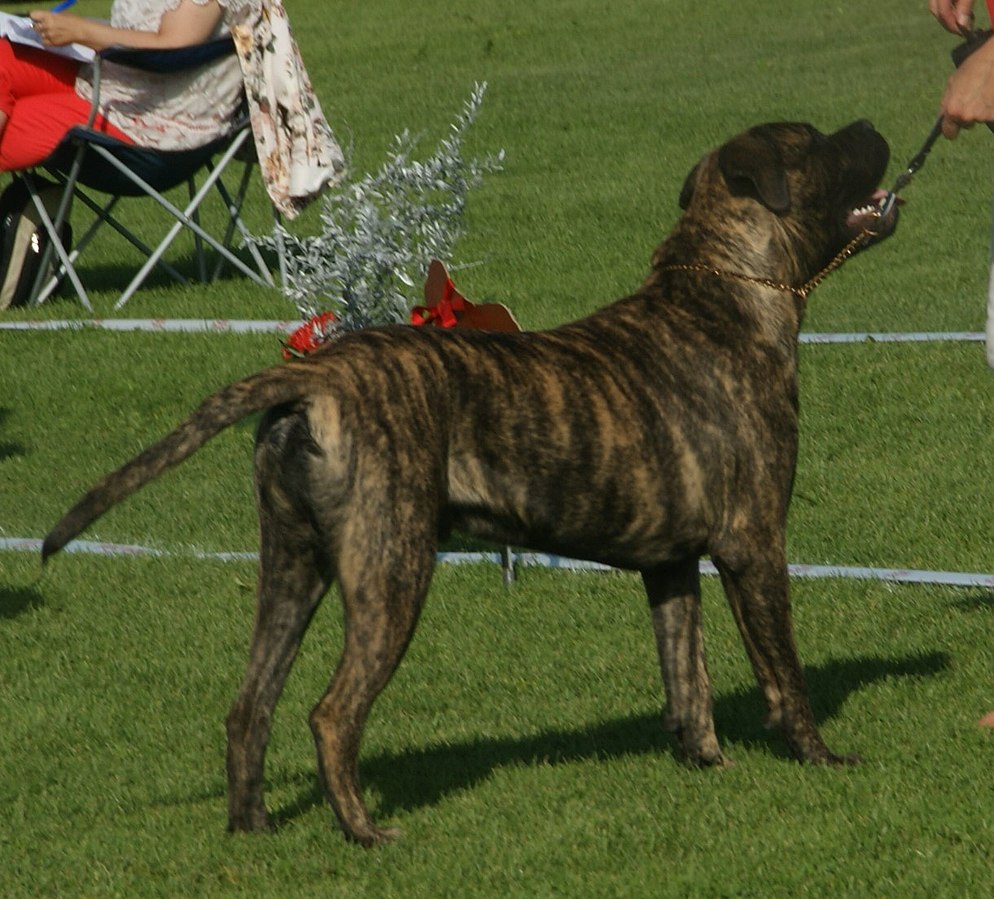The Italian Mastiff, also known as the Cane Corso, has a storied past that extends back to the Roman Empire. Renowned for its imposing presence and protective instincts, this mastiff breed has been a steadfast companion to humans, offering companionship and security.
Characterized by their muscular build, confident demeanor, and intelligence, Italian Mastiffs are well-suited to various roles, from guardians of property to loyal family pets. Their adaptability and trainability have earned them a revered place in the hearts of dog enthusiasts worldwide.
The visual appearance of this mastiff breed is striking, with a large head, square muzzle, and a robust frame that exudes strength and agility. Unlike some mastiff breeds that are heavier and more cumbersome, the Italian Mastiff displays a balance of power and grace, being less bulky and more athletic.
This breed comes with a short, easy-care coat, contributing to its practicality as a working dog. Despite their fierce appearance, Italian Mastiffs are known to be calm and quiet indoors, often displaying a mature composure as they age.
When considering bringing an Italian Mastiff into one’s life, it is crucial to understand that its size and strength require consistent training and socialization. This mastiff breed is often serious and self-assured around strangers, yet generally remains even-tempered, saving its more vigorous defenses for when it is truly aroused. For those capable of providing the necessary care, attention, and training, the Italian Mastiff can be a noble and devoted addition to the family, known for forming strong bonds with its owners and being responsive to their commands.
Breed Overview
The Italian Bull Mastiff, known for its robust stature and vigilant temperament, embodies the rich history of canine guardians in Italy. This section delves into the breed’s origin, distinctive physical traits, and characteristic behaviors.
Characteristic | Description |
|---|---|
Size | Large breed, with males typically weighing 130-150 lbs (59-68 kg) and females 100-130 lbs (45-59 kg). They stand 24-27 inches (61-69 cm) tall at the shoulder, giving them a massive and muscular appearance. |
Temperament | Loyal, devoted, and protective of their owners, yet docile and affectionate with family. Can be suspicious of strangers. |
Intelligence | Highly intelligent and responds well to training and socialization from an early age. |
Energy Level | Moderate energy, requiring daily exercise but also enjoying relaxation at home with their family. |
Grooming Needs | Short, dense coat requires minimal grooming with occasional brushing. |
Health Concerns | Generally a healthy breed, but can be prone to hip and elbow dysplasia, bloat, and other issues common in large breeds if not responsibly bred. |
Size and Appearance
The breed is characterized by its large, muscular frame. Males stand between 25 and 27.5 inches, while females are slightly smaller, measuring 23.5 to 26 inches at the withers. A broad head, square muzzle, and robust jawline mark the Italian Bull Mastiff’s appearance. Coat colors range from black, fawn, red, to gray, each complementing the breed’s imposing presence.
Temperament and Behavior
These mastiffs are known for their alert and intelligent demeanor. They exhibit a protective nature, making them excellent guardians of their home. Despite their daunting size, they possess a calm and loyal temperament, forging strong bonds with their families. However, their strong protective instincts can be overwhelming without guidance, so training and socialization are essential.
Origin and History

The Italian Bull Mastiff, also called the Cane Corso, is a breed with a lineage tracing back to ancient Rome, where it served as a war dog and agile hunter. Transitioning through time, its prominence as a multipurpose farm dog solidified, adept in protection and managing livestock.
The Cane Corso, or Italian Bull Mastiff, is an ancestor of the Roman Molossur. In its early days, this breed was a trusted war dog and a relentless hunter of wild beasts. Over time, its role transformed into a multi-talented farm dog proficiently safeguarding the home and driving livestock. The name is Cane Corso takes cues from ‘cohors,’ Latin for ‘guard of the courtyard’.
A Striking Canine: Physical Appearance

Glancing at a Cane Corso will reveal a well-muscled and solid canine, brandishing a wide, commanding face. With a range of color options such as black, fawn, chestnut, and blue, these canines can weigh as much as 130 pounds and stand nearly 27 inches tall. To add to their striking appearance, many typically showcase docked ears and tails. A magnificent display of Italian canine royalty.
In considering the health and lifespan of the Italian Bullmastiff, more commonly known as the Cane Corso, prospective owners should be aware of specific health challenges that the breed may face and their average life expectancy.
Common Health Issues
The Cane Corso is a robust breed but susceptible to certain health conditions. Hip dysplasia is a recurrent issue; it’s an inherited condition where the thighbone doesn’t fit snugly into the hip joint, leading to arthritis or lameness.
Another significant health concern is bloat, or gastric torsion, which is potentially fatal and can cause the stomach to twist and fill with gas. Regular health evaluations by a veterinarian can help identify and manage these conditions early on.
Life Expectancy
The life expectancy of the Cane Corso is generally between 9 to 11 years. Factors like genetics, diet, exercise, and regular veterinary care play crucial roles in the longevity and well-being of these canines. Ensuring a balanced lifestyle is imperative to maximize the lifespan of these noble creatures.
Characteristics of the Italian Bull Mastiff

Affectionate and Protectively Instinctual
Adopting a Cane Corso brings home not just a pet but a loyal family member. They tend to be obedient, loving, protective, and have a natural wariness towards strangers. This combination makes them excellent home guards, standing their ground until the owner signals all clear.
Socialization forms an integral part of their upbringing. In order to establish boundaries, they will need clear obedience training and an understanding of household rules. An owner must be assertive yet calm, making way for a respectful canine-human bond.
Care and Maintenance
The Italian Bullmastiff, a robust and noble breed, demands specific care routines to maintain its health and happiness. Focusing on a balanced diet, sufficient exercise, and regular grooming will significantly contribute to their well-being.
Feeding and Diet
Italian Bullmastiffs require a diet that supports their large size and energy levels. High-quality dog food with a balanced proportion of protein, fats, and carbohydrates is essential for their daily nutrition. Portion control is crucial to prevent obesity, especially because they are prone to weight gain. Generally, an adult Italian Bullmastiff does well on about 2.5 to 3 cups of dry dog food each day, divided into two meals. Owners should adjust portions according to the dog’s activity level, age, and weight.
Exercise Requirement and Energy Levels
Despite their size, Italian Bullmastiffs have moderate energy levels. Daily exercise such as a brisk 30-minute walk is usually sufficient to keep them fit. However, they should not be over-exercised, particularly in hot weather, due to their susceptibility to overheating.
Mental stimulation and training exercises also help keep their minds active, avoiding potential destructive behavior due to boredom.Daily provision for the following is necessary:
- At least a mile of brisk walk
- Adequate playtime.
Although a large breed, the Italian Bull Mastiff’s need for companionship is just as immense. They flourish best with daily interaction and bond-building activities.
Grooming and Shedding
Although Italian Bullmastiffs have short fur coat, they do experience seasonal shedding. Regular brushing, at least once a week, helps to remove loose fur and maintain the coat’s shine. During shedding seasons, more frequent brushing might be necessary to manage the excess hair.
Bathing should be done as needed but not too frequently to preserve the natural oils in their skin. Additionally, routine maintenance such as nail trimming and ear cleaning is part of a comprehensive grooming regimen essential for their overall health.
Training and Socialization
Training and socialization form the cornerstone of raising a well-behaved Italian Bull Mastiff. A consistent approach and positive reinforcement cultivate obedience and a sociable temperament in these intelligent canines.
Basic Obedience
Beginning with basic commands such as “sit,” “stay,” “come,” and “heel” establishes a foundation of obedience training. The Italian Bull Mastiff responds well to positive reinforcement, which includes verbal praise, food rewards, and pets. Owners should exhibit patience and consistency during training sessions to reinforce learned behaviors.
- Start training sessions short, gradually increasing duration
- Use high-value treats to reward and motivate
- Maintain a firm, gentle tone to encourage focus
Social Skills
Social skills are crucial for preventing the development of overly protective and aggressive tendencies. Introducing an Italian Bull Mastiff to various people, environments, and other animals early on is recommended, especially during their critical socialization period, typically before they turn 14 weeks old.
- Enroll the puppy in a puppy socialization class
- Schedule regular playdates with other dogs
- Expose them to different stimuli in a controlled manner
Living with an Italian Bull Mastiff
Owners of an Italian Bull Mastiff should prepare for a life enriched with loyalty and protection. This breed thrives on integration with its human family and manifests a robust guarding instinct.
Family Integration
Italian Bull Mastiffs are fiercely loyal to their families. They seek to embed themselves into household routines, demonstrating profound companionship and an affinity for closeness. When socialized properly, they can coexist harmoniously with children and other pets. It is vital to foster respectful interactions, especially in homes with younger kids, to ensure a nurturing environment.
Guarding and Protective Instincts
Italian Bull Mastiffs have a natural propensity for protection, with their roots tracing back to roles as guard dogs in historical settings. They make excellent watchdogs, always alert to unfamiliar sounds or presences.
Despite their formidable size, they typically refrain from needless aggression, but they will become protective when they perceive threats against their family members. The Italian Bull Mastiff’s presence alone is often enough to deter intruders, underpinning their reputation as steadfast guardians.
Is the Italian Bull Mastiff the Right Breed for You?

While an Italian Bull Mastiff enriches the family with their loyalty and protectiveness, it’s important to assess if you’re the right owner for them. Living with this breed needs patience, commitment to training, a fearless disposition, and an ability to assert authority.
Introducing this majestic breed into your home is an endeavor, but the rewards through their steadfast loyalty, affection, and spirit are immeasurable.
Consider your Italian Bull Mastiff journey further by exploring the informative articles listed below: